Abstract
The successful cultivation of the anaerobic ciliate Dasytricha ruminantium is described. The cultures were established in a salts medium containing 30% clarified rumen fluid. Sucrose and extract of rumen holotrich protozoa were fed once daily for 2 to 4 hr, and Dasytricha was then transferred to medium free from these nutrients. Rumen fluid was essential. Omission of protozoal extract resulted in gradual death of the ciliates. Bovine serum satisfactorily substituted for the protozoal extract, but various rumen bacteria, extract of rumen bacteria, and extracts of plant materials could not. There was a positive correlation between formation of methane in the cultures and growth of the ciliates. It is possible that methane bacteria were ingested, but it is not excluded that survival of both dasytrichs and the methanogenic bacteria depended on a low redox potential of the medium.
Full text
PDF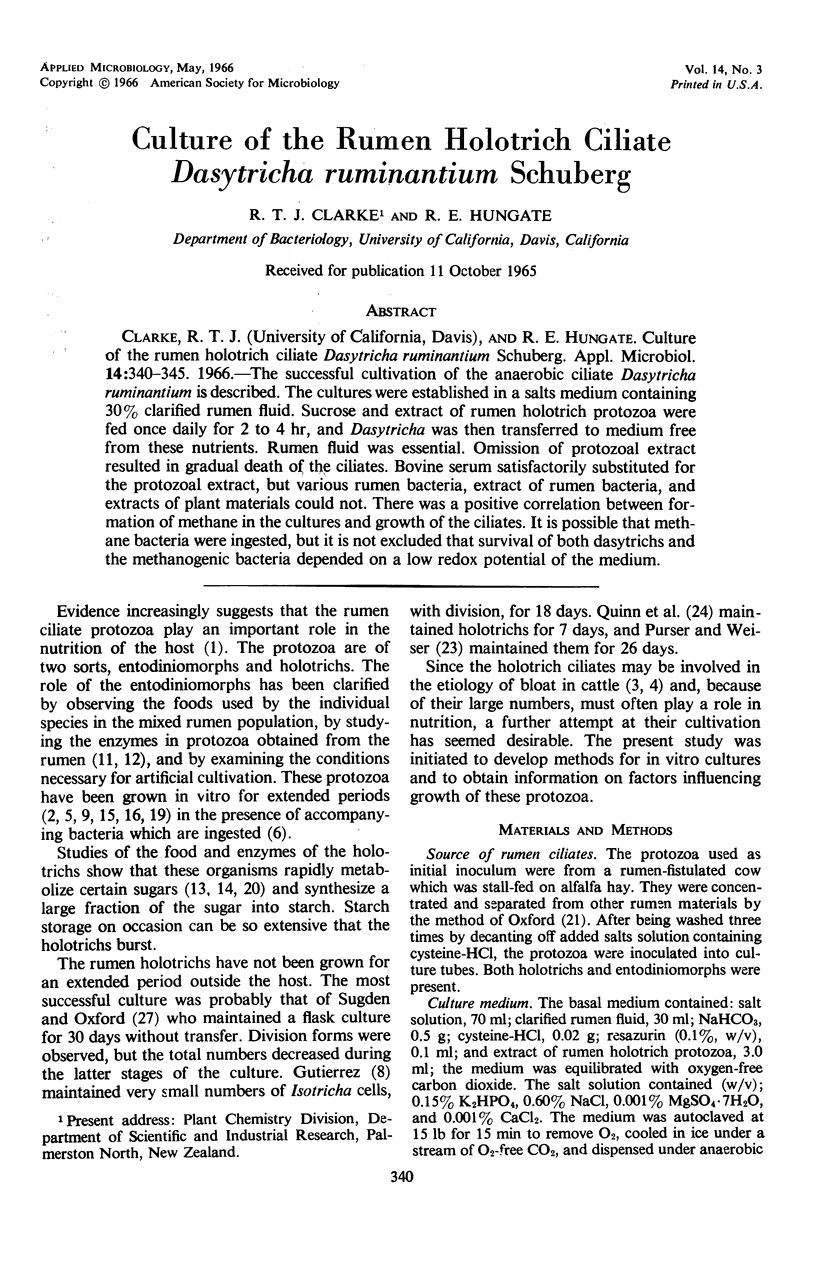
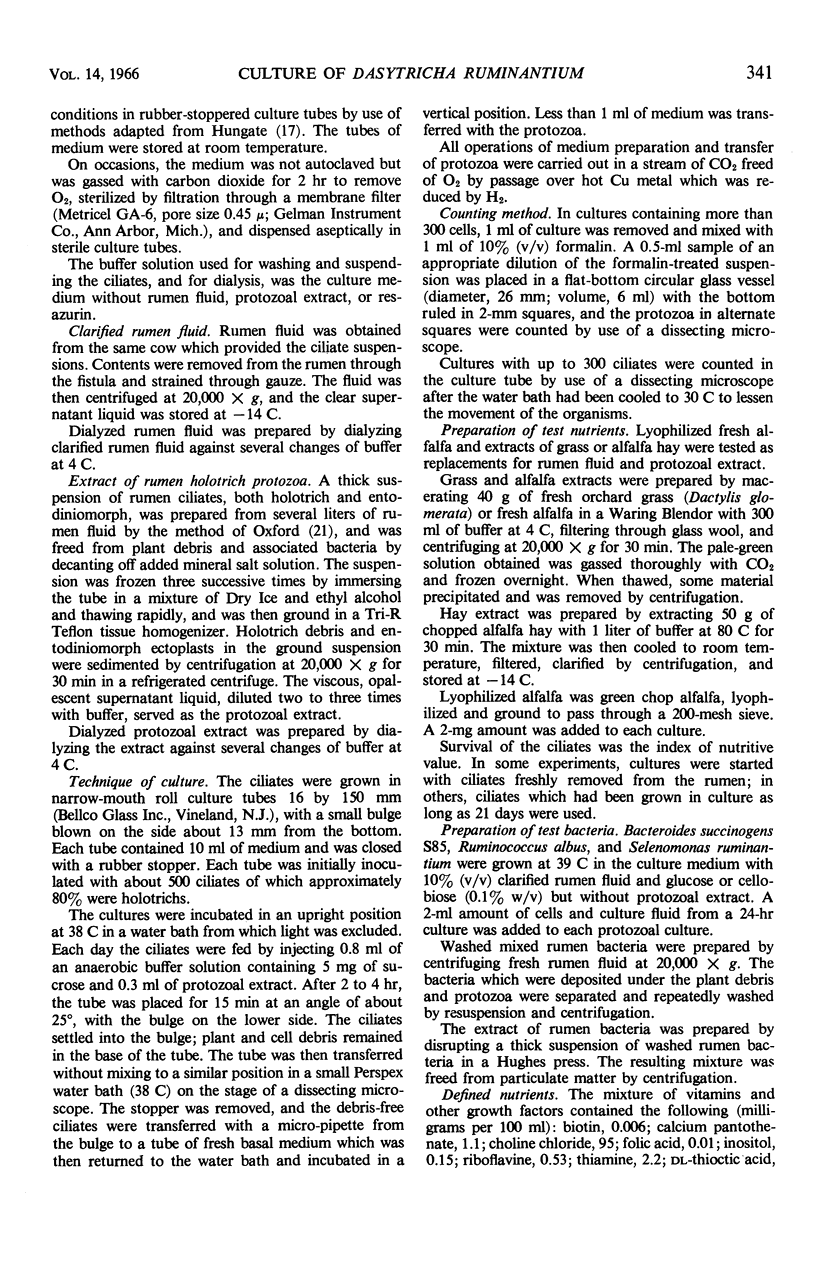
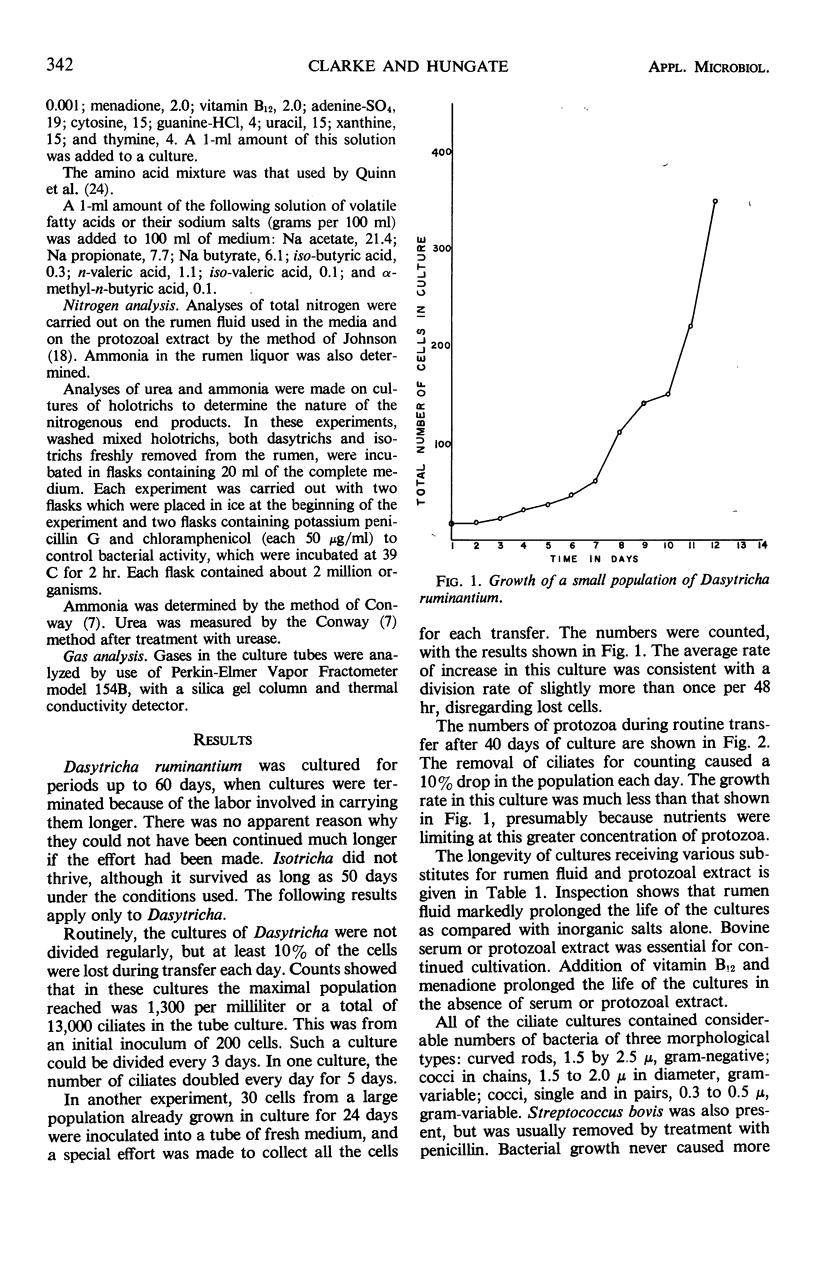
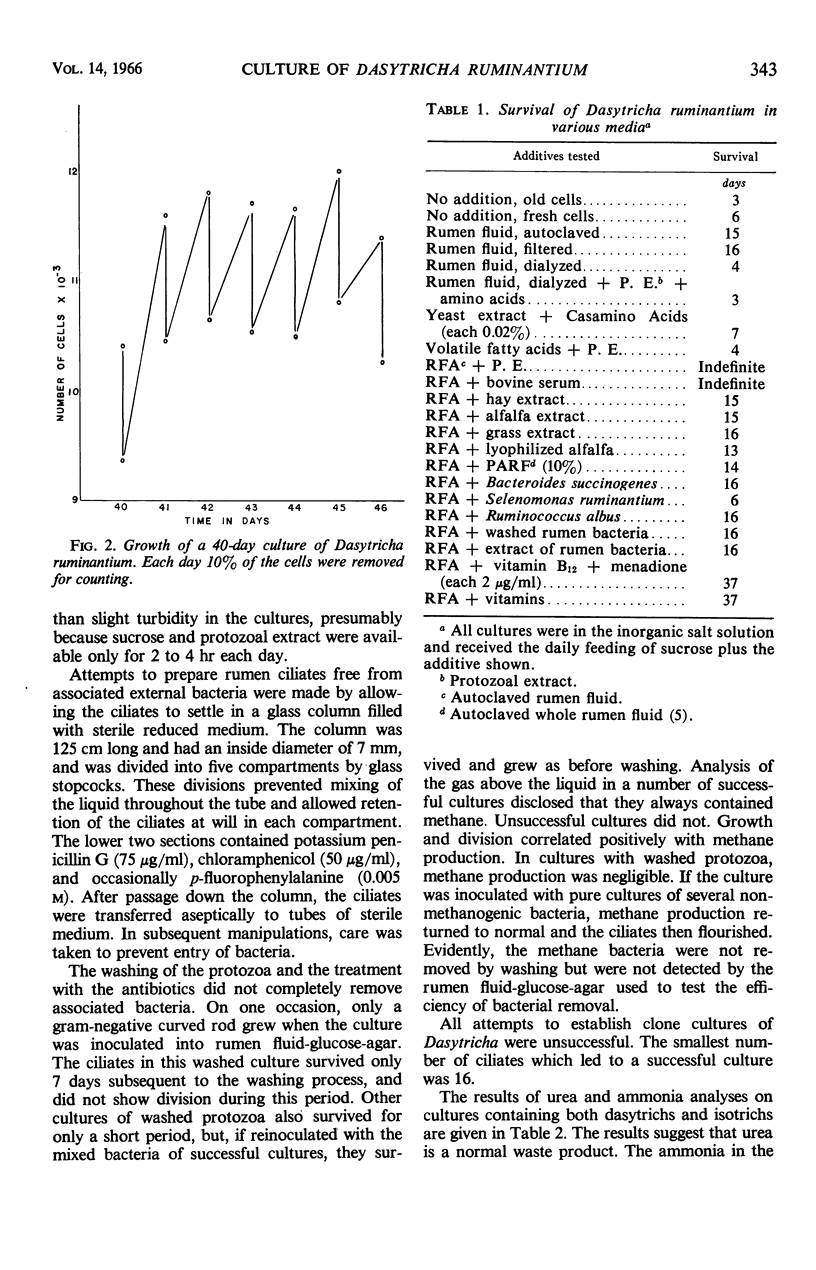
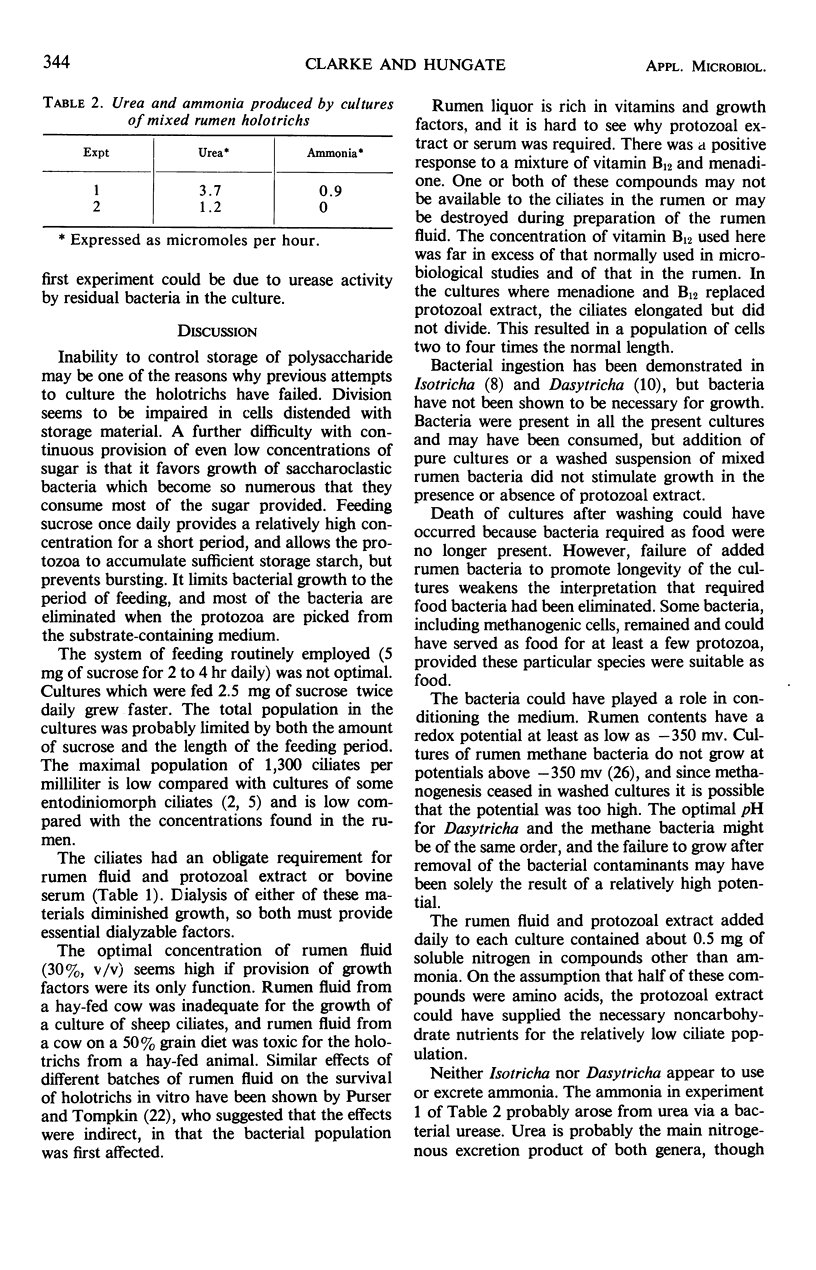
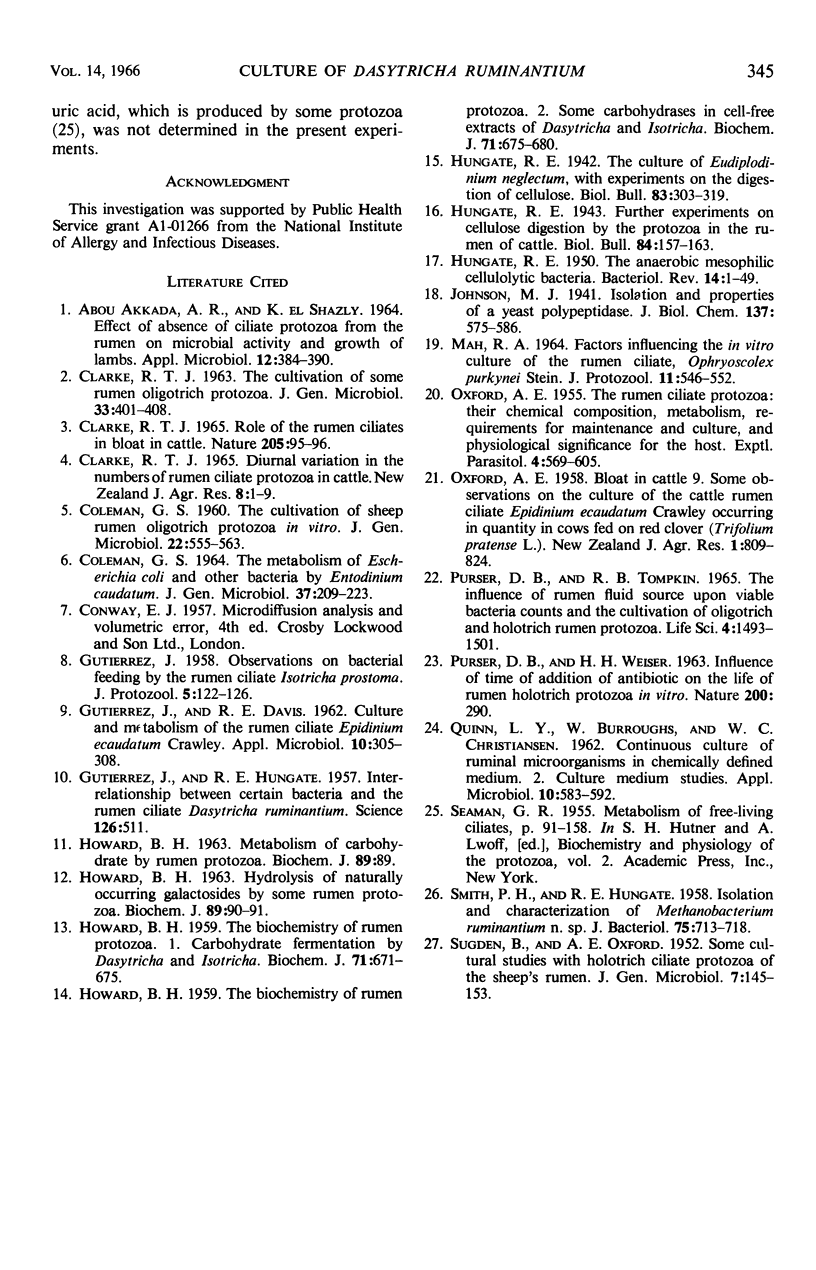
Selected References
These references are in PubMed. This may not be the complete list of references from this article.
- ABOUAKKADA A. R., EL-SHAZLY K. EFFECT OF ABSENCE OF CILIATE PROTOZOA FROM THE RUMEN ON MICROBIAL ACTIVITY AND GROWTH OF LAMBS. Appl Microbiol. 1964 Jul;12:384–390. [PMC free article] [PubMed] [Google Scholar]
- CLARKE R. T. ROLE OF THE RUMEN CILIATES IN BLOAT IN CATTLE. Nature. 1965 Jan 2;205:95–96. doi: 10.1038/205095b0. [DOI] [PubMed] [Google Scholar]
- CLARKE R. T. THE CULTIVATION OF SOME RUMEN OLIGOTRICH PROTOZOA. J Gen Microbiol. 1963 Dec;33:401–408. doi: 10.1099/00221287-33-3-401. [DOI] [PubMed] [Google Scholar]
- COLEMAN G. S. THE METABOLISM OF ESCHERICHIA COLI AND OTHER BACTERIA BY ENTODINIUM CAUDATUM. J Gen Microbiol. 1964 Nov;37:209–223. doi: 10.1099/00221287-37-2-209. [DOI] [PubMed] [Google Scholar]
- COLEMAN G. S. The cultivation of sheep rumen oligotrich protozoa in vitro. J Gen Microbiol. 1960 Apr;22:555–563. doi: 10.1099/00221287-22-2-555. [DOI] [PubMed] [Google Scholar]
- GUTIERREZ J., HUNGATE R. E. Interrelationship between certain bacteria and the rumen ciliate Dasytricha ruminantium. Science. 1957 Sep 13;126(3272):511–511. doi: 10.1126/science.126.3272.511. [DOI] [PubMed] [Google Scholar]
- Gutierrez J., Davis R. E. Culture and Metabolism of the Rumen Ciliate Epidinium ecaudatum Crawley. Appl Microbiol. 1962 Jul;10(4):305–308. doi: 10.1128/am.10.4.305-308.1962. [DOI] [PMC free article] [PubMed] [Google Scholar]
- HOWARD B. H. The biochemistry of rumen protozoa. 1. Carbohydrate fermentation by Dasytricha and Isotricha. Biochem J. 1959 Apr;71(4):671–675. doi: 10.1042/bj0710671. [DOI] [PMC free article] [PubMed] [Google Scholar]
- HOWARD B. H. The biochemistry of rumen protozoa. 2. Some carbohydrases in cell-free extracts of Dasytricha and Isotricha. Biochem J. 1959 Apr;71(4):675–680. doi: 10.1042/bj0710675. [DOI] [PMC free article] [PubMed] [Google Scholar]
- HUNGATE R. E. The anaerobic mesophilic cellulolytic bacteria. Bacteriol Rev. 1950 Mar;14(1):1–49. doi: 10.1128/br.14.1.1-49.1950. [DOI] [PMC free article] [PubMed] [Google Scholar]
- MAH R. A. FACTORS INFLUENCING THE IN VITRO CULTURE OF THE RUMEN CILIATE OPHRYOSCOLEX PURKYNEI STEIN. J Protozool. 1964 Nov;11:546–552. doi: 10.1111/j.1550-7408.1964.tb01796.x. [DOI] [PubMed] [Google Scholar]
- OXFORD A. E. The rumen ciliate protozoa: their chemical composition, metabolism, requirements for maintenance and culture, and physiological significance for the host. Exp Parasitol. 1955 Nov;4(6):569–605. doi: 10.1016/0014-4894(55)90045-x. [DOI] [PubMed] [Google Scholar]
- PURSER D. B., TOMPKIN R. B. THE INFLUENCE OF RUMEN FLUID SOURCE UPON VIABLE BACTERIA COUNTS AND THE CULTIVATION OF OLIGOTRICH AND HOLOTRICH RUMEN PROTOZOA. Life Sci. 1965 Aug;4:1493–1501. doi: 10.1016/0024-3205(65)90169-4. [DOI] [PubMed] [Google Scholar]
- PURSER D. B., WEISER H. H. INFLUENCE OF TIME OF ADDITION OF ANTIBIOTIC ON THE IN VITRO LIFE OF RUMEN HOLOTRICH PROTOZOA. Nature. 1963 Oct 19;200:290–290. doi: 10.1038/200290a0. [DOI] [PubMed] [Google Scholar]
- QUINN L. Y., BURROUGHS W., CHRISTIANSEN W. C. Continuous culture of ruminal microorganisms in chemically defined medium. II. Culture medium studies. Appl Microbiol. 1962 Nov;10:583–592. doi: 10.1128/am.10.6.583-592.1962. [DOI] [PMC free article] [PubMed] [Google Scholar]
- SMITH P. H., HUNGATE R. E. Isolation and characterization of Methanobacterium ruminantium n. sp. J Bacteriol. 1958 Jun;75(6):713–718. doi: 10.1128/jb.75.6.713-718.1958. [DOI] [PMC free article] [PubMed] [Google Scholar]
- SUGDEN B., OXFORD A. E. Some cultural studies with holotrich ciliate protozoa of the sheep's rumen. J Gen Microbiol. 1952 Aug;7(1-2):145–153. doi: 10.1099/00221287-7-1-2-145. [DOI] [PubMed] [Google Scholar]


